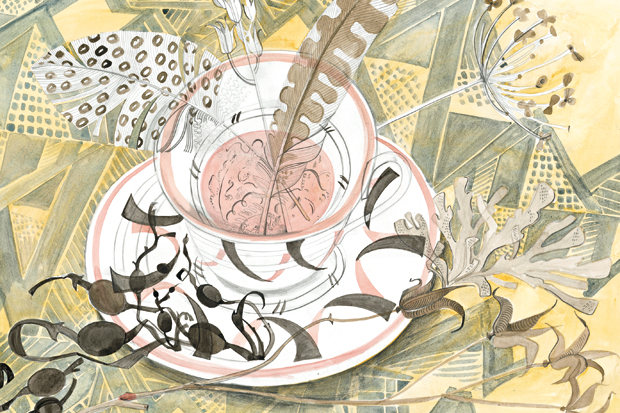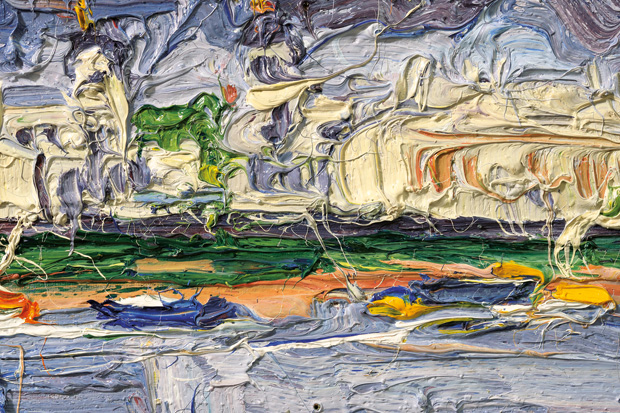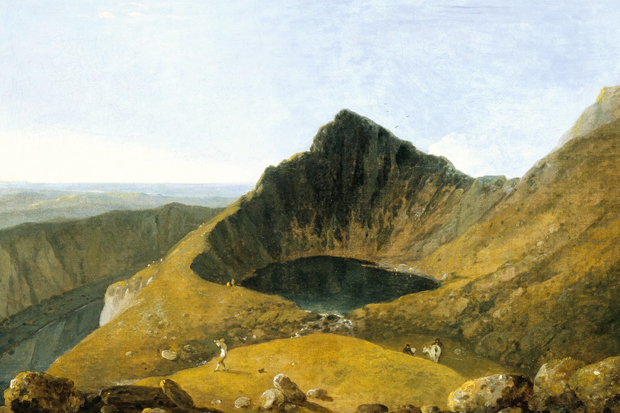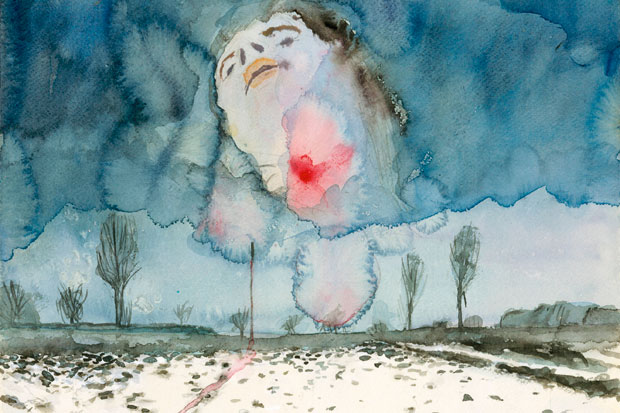A day trip to the Towner Art Gallery in Eastbourne is a summer pleasure, and two concurrent shows are proving a considerable draw, with their focus on design and applied art. Designing the Everyday is in some ways just an excuse to get out all the best Ravilious china and show it with his working drawings, but where’s the harm in that? Ravilious continues to be one of the most popular of 20th-century British artists, and his applied art is not as well known as his pellucid watercolours, so here’s a chance to remedy that. And to put it in context, the surrounding rooms examine work from both earlier and later periods: a light-hearted and enjoyable selection by guest curator Nathaniel Hepburn.
Room 1 deals with Roger Fry’s Omega Workshop and includes a couple of lovely Gaudier-Brzeska sculptures — a bronze sleeping fawn and an earthenware cat — together with Fry’s own ceramic jug, large, white and rather chipped. Around the walls are some interesting things: an oil by Frederick Etchells entitled ‘A Group of Figures’, also his hand-knotted wool rug for the 1913 Ideal Home Exhibition, a geometric Vorticist design in yellow, blue, pink and grey. Etchells, a painter turned architect, is an intriguing figure and needs more exposure.
Here, too, is a series of stylised Wyndham Lewis designs for lampshades and a couple of his ink drawings. Then follows a room of Shell’s memorable 1930s lithographed posters, McKnight Kauffer and John Armstrong to the fore, also Cedric Morris, Edward Bawden and Graham Sutherland. A third room takes ‘Modern Art for the Table’ in 1934 as a theme, with unexpected designs by Paul Nash, also Armstrong and Sutherland again. A wall of Ravilious plates makes a tremendous display, and there’s a whole room devoted to his work for Wedgwood. Note the three glorious Coronation mugs.
Representing 1944–55 is a room of Ascher fabrics, artists’ designs screenprinted on to silk or rayon scarves. The best here are by Ben Nicholson, Ivon Hitchens and Sutherland (yet again), who stars with an elegant black trellis. The last room jumps 50 years and is full of contemporary work by a group of talented young(ish) artists who look back to an earlier period of British art for their inspiration. Piper and Bawden are their guiding lights, and the work of such as Angie Lewin and Mark Hearld is a highly conscious and very successful throwback to the 1950s. Of the artists shown here I was most impressed by Ed Kluz (born 1980) who seems to be doing something more original with his collaged approach.
Upstairs is a show devoted to the artist and designer Peggy Angus (1904–93), best known as the owner of a remote and primitive cottage called Furlongs on the Sussex Downs near Lewes. The house is celebrated in a number of paintings by Ravilious, who used to stay there regularly, along with the likes of John Piper and Percy Horton. The story of Peggy Angus and her friends is an entertaining one, but the problem of putting together an exhibition of her work is that she wasn’t a very good painter. Clearly her design work is of a far higher quality than her oils and watercolours, but it’s very difficult to make a convincing show from tiles and wallpaper samples. The Towner’s large main galleries look sadly empty: there’s simply not enough work to fill the space. On this showing, Angus’s achievement is too meagre to warrant such a survey.
That said, there are good things here, such as Percy Horton’s portraits of her and an enjoyably vigorous undated collage by Angus herself called ‘Chopping Logs’. But her oil of the same subject hung next to it demonstrates how uninspired a painter she could be. There are a couple of pictures that encourage one to hope for better things (‘The Cabbage Patch’ and ‘Haymaking’), and a group of coloured portrait drawings (of John Piper, Ravilious and Maurice De Sausmarez), but by and large Angus’s paintings are dull. However, there are not many artists who can stand up to close comparison with Ravilious, so hanging his paintings next to hers (‘Dolly Engine’ beside her four cement works oils) looks like deliberate sabotage.
Last chance to see an absolutely delightful show of pastoral etchings at Mascalls Gallery in rural Kent. A highly focused exhibition (34 framed works and two flat cabinets of letters, drawings and etching plates), it’s all in black and white, and the images themselves are small, but the effect is life-enhancing. These etchings transport the viewer to a more contemplative agrarian world of ploughmen, shepherds, woods and fields, of star-strewn night skies, thatched cottages and great trees. Here is rest for the spirit and a welcome opportunity for reverie in our hustled lives.
The exhibition begins with a concise visual preface of three prints, one each by Rembrandt, Whistler and Seymour Haden, to loosen up the eye, sharpen expectations and set the pace. Then we’re straight into the meat of the show, with three of Graham Sutherland’s early etchings from 1923–4, which first made his reputation. Sutherland is the key to the exhibition — one of Mascalls’ important early shows was devoted to Sutherland (1903–80), who lived not far away at Trottiscliffe, so there is much local relevance here — the hub around which the display revolves. His etchings are interspersed with those of his contemporary Paul Drury (1903–87) and of their shared inspiration and model Samuel Palmer (1805–81).
Both Palmer and Drury come across very well. ‘The Herdsman’s Cottage’ (1850) by Palmer, which was to have such an influence on the young and impressionable Sutherland and Drury, with its unforgettable glimmering of light through darkness, opens the second room. Here also are fine things such as Drury’s ‘September’ (1928) and Sutherland’s ‘Lammas’ (1926). The etched images are densely worked yet paradoxically light-filled: the white of the paper is at a premium (and thus much enhanced) when hemmed around by inked lines. Sutherland is particularly good at achieving a kind of beaded ground cover, which interrupts and intensifies the light, and there is no doubt about the spiritual presence conveyed by this play of brightness and shadow.
Dreaming hills feature large: the Lonely Tower on Leith Hill near Dorking, marking the village where Samuel Palmer’s eldest son died; Box Hill as depicted by Paul Drury; and Sutherland’s Hangar Hill. This is where the mood begins to turn, and the Golden Age of yore gives way to the pessimism and despair of the modern period. Sutherland’s infant son died the year that etching was made, 1929, and the forms seem to reflect this, the ivy-throttled tree trunks shooting out twisted, groping branches. In ‘Wood Interior’ the melancholy is more profound, and in ‘Pastoral’ (1930), though a beautiful etching, decay is even more prominent. The last print, entitled ‘The Garden’, featuring a close-pruned but aspiring rosebush, suggests the way forward — into Neo-Romanticism and the emotional paraphrase of nature that was to mark a new phase in his career. Meanwhile, these early etchings — most of which look as if they could be by quite a different artist from the mature Sutherland of the portraits and the intensely coloured landscapes — offer subtler pleasures, shown as they are here to very good effect.
Got something to add? Join the discussion and comment below.
Get 10 issues for just $10
Subscribe to The Spectator Australia today for the next 10 magazine issues, plus full online access, for just $10.
You might disagree with half of it, but you’ll enjoy reading all of it. Try your first month for free, then just $2 a week for the remainder of your first year.














Comments
Don't miss out
Join the conversation with other Spectator Australia readers. Subscribe to leave a comment.
SUBSCRIBEAlready a subscriber? Log in